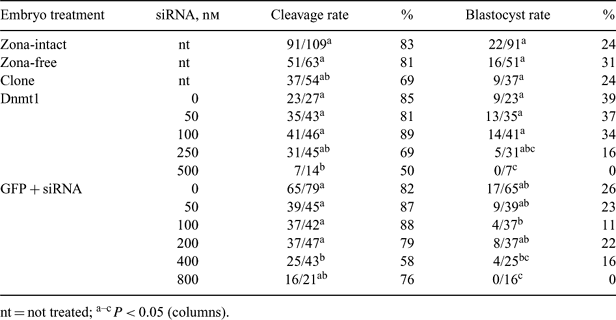120 EMBRYO SURVIVAL FOLLOWING LIPID-BASED TRANSFECTION OF 1-CELL STAGE BOVINE EMBRYOS WITH SMALL INTERFERING RNA (siRNA) FRAGMENTS AND/OR DNA
M. Bertolini A B , L. R. Bertolini B , S. G. Petkov A , K. R. Madden C , J. D. Murray B and G. B. Anderson BA Embryo Transfer Laboratory, Department of Animal Science, University of California, Davis, CA, USA
B Transgenics Laboratory, Department of Animal Science, University of California, Davis, CA, USA
C Invitrogen Co., Carlsbad, CA, USA
Reproduction, Fertility and Development 18(2) 168-169 https://doi.org/10.1071/RDv18n2Ab120
Published: 14 December 2005
Abstract
The RNA interference (RNAi) technology is a powerful tool for studies in functional genomics. The aim of this study was to evaluate the effects of a cationic lipid-based small interfering RNA (siRNA) and/or DNA delivery to 1-cell-stage bovine embryos on survival to the blastocyst stage. In vitro-produced (IVP) embryos were generated according to Bertolini et al. 2002 (Theriogenology 58, 973), and cloned embryos were produced by the handmade cloning technique (Vajta et al. 2003 Biol. Reprod. 68, 571) using green fluorescent protein (GFP)-expressing fibroblast cells as nuclear donors. Lipofections were performed on zona-free 1-cell-stage IVP embryos at 24–28 h post-fertilization by exposure to 1% (v/v) Lipofectamine 2000 (Invitrogen Co., CA, USA), 0.002% (w/v) GFP plasmid (pEFGP-N1, Clontech Laboratories, CA, USA) and/or various doses of siRNA GFP-specific siRNA oligonucleotide (Invitrogen) or DNA methyltransferase 1 (Dnmt1)-specific siRNA fragments for 60 min at 39°C, according to 5 treatment groups: (1) zona-intact IVP embryos (controls), (2) zona-free control embryos (controls for embryo development after zona removal), (3) embryos treated with GFP + GFP-siRNA at 0, 50, 100, 200, 400, or 800 nm, (4) embryos treated with Dnmt1-siRNA at 0, 50, 100, 250, or 500 nm, and (5) cloned embryos (positive controls for GFP expression). After treatment, embryos were in vitro-cultured in a WOW culture system (Vajta et al. 2000 Mol. Reprod. Dev. 55, 256) for 7 days. Cleavage and developmental rates to at least 8-cell and to blastocyst stages were assessed at 48, 96, and 168 h post-fertilization (hpf), respectively. Data were analyzed by the chi-square test. Cleavage rates in embryos treated with higher doses of siRNA were lower than in all other groups (Table 1). Embryo survival to at least 8-cell stage at 48 h, based on cleavage, was similar among all treatments (data not shown), but survival to blastocyst stage was affected by higher doses of GFP- or Dnmt1-siRNA (Table 1). After a qualitative assessment by fluorescence microscopy at 168 hpf, 40 to 63% of GFP-transfected blastocysts showed various levels of fluorescence, irrespective of the siRNA treatments. Fragments of siRNA are known to be short-lived in cultured cells, although we are still uncertain of their behavior and effects in early bovine embryos. We are currently analyzing the effectiveness of the siRNA transfection in the early IVP and clone embryo. In conclusion, liposome transfection of 1-cell-stage embryos did not affect survival and development to the blastocyst stage. However, survival followed an siRNA dose-response effect, with doses higher than 400 nm appearing to be detrimental to embryo development, with a developmental arrest at or close to the embryonic genome activation period.

|


